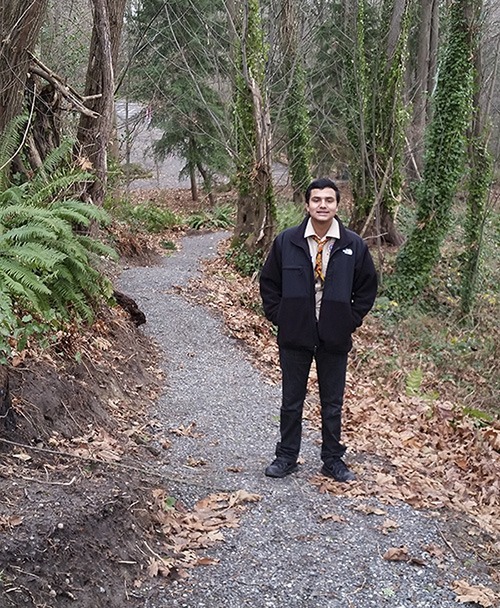A Boy Scout reaches the rank of Eagle Scout by earning 21 merit badges, serving six months in a troop leadership position and planning, developing and leading a service project for a religious organization, school or community. But as Islander Rajan Parikh has learned, some service projects are harder than others.
Parikh’s Eagle project was to design and build a new 250-foot trail at Clarke Beach. The trail would start at the intersection of East Mercer Way at S.E. 78th Place, and connect to the parking lot at Clarke Beach.
Parikh found his project through the City of Mercer Island’s arborist, Paul West, and Andrew Prince of the city’s Parks and Recreation department.
Parikh, 15, a member of Mercer Island Scout Troop 624, had set a schedule to clear and pave the path with gravel over two Saturdays, Oct. 18 and 25. The work had to be done soon, as fall was approaching and the rain would return.
The first step was to clear and smooth a pathway cut into the side of a hill. This meant a lot of dirt had to be moved to make sure the path stayed even and flat; and that the slope both above and below was supported and would remain stable.
There was a lot of hard work and some fun.
“The coolest thing that happened during the project was that we found an old [clothes] washer in the forest,” Parikh said.
Some of the scouts dragged it out to the trailhead. The scouts decided that if they could, they would name it the ‘Washer Trail.’ But a truck came and hauled it away.
The first day went well, but there was much left to do. Between the two work days, the Mercer Island High School sophomore met with West and Prince to discuss any alterations before finishing the trail.
A few changes were indeed needed. It meant even more work.
“On paper, the work did not seem like so much,” he said.
Parikh said he was worried as the second workday approached.
“I had no idea what I was in for,” he said of the project. “It was much more complicated than I thought.”
And on the second day, there would be fewer people to help. But as the work started, things started to look brighter.
The morning rains turned into sunlight, and in what seemed like few minutes, they had taken out a big tree root, cut out shrubbery to make room for the cribbing and had evened out most of the trail, he said.
After a lunch break, the scout dispatched half of the people to begin laying gravel while the others started building the cribbing along the slopes.
Soon it was time to call in some more gravel. But the truck delivering the gravel got stuck. The crew dropped what they were doing to get the truck out. The group had lost two hours of precious time.
But despite the setbacks, the project came together as the cribbing structure was completed. The entire trail and cribbing structure was filled with gravel.
“After a few high-fives, fist bumps, and cheers, we put away all the tools and supplies, took a few pictures and gladly went home,” he said. “I remember going home still not believing that we had just completed something that two months ago was nothing more than a speck of an idea.
“I have much more respect for the people who build these things.”


